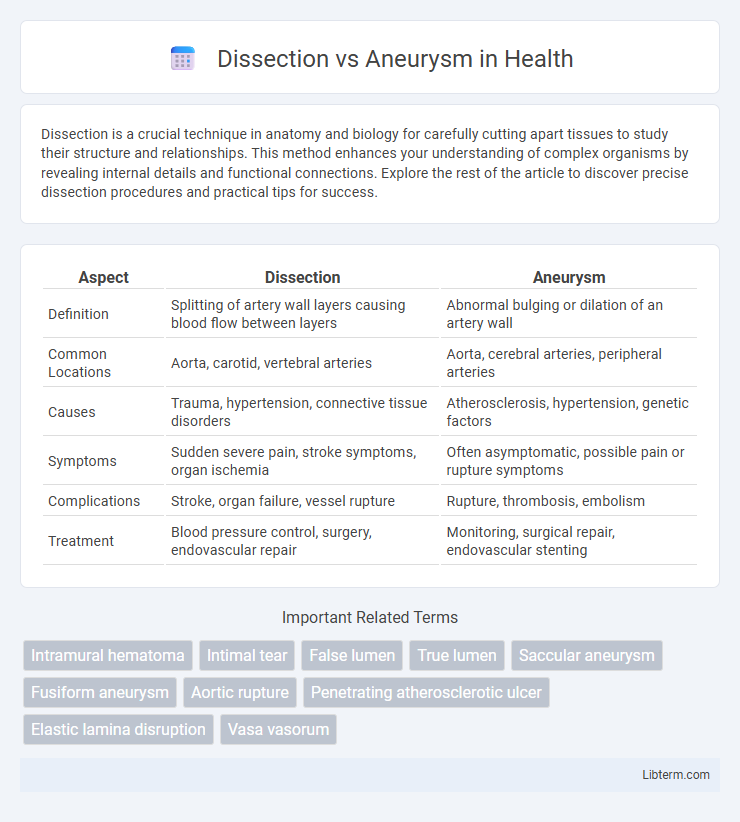Dissection is a crucial technique in anatomy and biology for carefully cutting apart tissues to study their structure and relationships. This method enhances your understanding of complex organisms by revealing internal details and functional connections. Explore the rest of the article to discover precise dissection procedures and practical tips for success.
Table of Comparison
| Aspect | Dissection | Aneurysm |
|---|---|---|
| Definition | Splitting of artery wall layers causing blood flow between layers | Abnormal bulging or dilation of an artery wall |
| Common Locations | Aorta, carotid, vertebral arteries | Aorta, cerebral arteries, peripheral arteries |
| Causes | Trauma, hypertension, connective tissue disorders | Atherosclerosis, hypertension, genetic factors |
| Symptoms | Sudden severe pain, stroke symptoms, organ ischemia | Often asymptomatic, possible pain or rupture symptoms |
| Complications | Stroke, organ failure, vessel rupture | Rupture, thrombosis, embolism |
| Treatment | Blood pressure control, surgery, endovascular repair | Monitoring, surgical repair, endovascular stenting |
Understanding Dissection and Aneurysm
Dissection occurs when a tear in the inner layer of a blood vessel allows blood to flow between the layers of the vessel wall, creating a false lumen that can restrict blood flow or lead to rupture. An aneurysm is a localized dilation or ballooning of a weakened blood vessel wall, increasing the risk of rupture and potentially causing life-threatening bleeding. Understanding the structural differences and pathophysiology of dissection and aneurysm is crucial for accurate diagnosis, risk assessment, and targeted treatment strategies.
Key Differences Between Dissection and Aneurysm
Dissection involves a tear in the artery wall causing blood to flow between the layers, whereas an aneurysm is a localized dilation or ballooning of a blood vessel due to weakness in the vessel wall. Dissections often result in compromised blood flow and can lead to vessel rupture, while aneurysms primarily pose a risk of rupture and subsequent hemorrhage. Imaging techniques like CT angiography and MRI are crucial for differentiating dissections, which show the false lumen, from aneurysms, which present as a saccular or fusiform vessel enlargement.
Causes of Dissection and Aneurysm
Arterial dissection occurs when a tear in the vessel's intimal layer allows blood to enter and split the vessel wall, often triggered by trauma, hypertension, or connective tissue disorders such as Marfan syndrome. Aneurysms develop due to the weakening of the arterial wall from factors including atherosclerosis, genetic predispositions, chronic hypertension, and infections like syphilis. Understanding these distinct pathophysiological causes aids in the diagnosis and targeted treatment of vascular diseases.
Common Symptoms to Watch For
Dissection and aneurysm both involve abnormalities in blood vessels but present with distinct symptoms to watch for. Common symptoms of a dissection include sudden, severe chest or back pain described as tearing, along with shortness of breath, weakness, or stroke-like signs in some cases. Aneurysm symptoms often involve a pulsating bulge in arteries, localized pain, or pressure effects on nearby organs, although many aneurysms remain asymptomatic until rupture occurs.
Diagnostic Methods for Vascular Disorders
Diagnostic methods for vascular disorders such as dissection and aneurysm include computed tomography angiography (CTA) and magnetic resonance angiography (MRA), which provide detailed images of blood vessel structure and integrity. Doppler ultrasound is frequently used to assess blood flow and detect abnormalities in vessel walls. Digital subtraction angiography (DSA) remains the gold standard for precise visualization, particularly in complex cases requiring intervention planning.
Risk Factors and Prevention Strategies
Dissection and aneurysm share overlapping risk factors such as hypertension, smoking, connective tissue disorders, and advanced age, which contribute to vessel wall weakening and increased susceptibility. Prevention strategies emphasize blood pressure control, smoking cessation, regular cardiovascular monitoring, and managing underlying conditions like Marfan syndrome or Ehlers-Danlos syndrome to reduce the risk of vessel wall damage. Early detection through imaging techniques and lifestyle modifications remain critical in minimizing complications and improving patient outcomes.
Treatment Options and Management
Dissection treatment primarily involves blood pressure control with beta-blockers and anticoagulation or antiplatelet therapy to prevent thromboembolism, with surgery reserved for complications or unstable patients. Aneurysm management varies by size and risk factors, often starting with regular imaging surveillance and blood pressure management, escalating to endovascular repair or open surgery for large, symptomatic, or rapidly expanding aneurysms. Both conditions require individualized monitoring and multidisciplinary care to optimize outcomes and minimize the risk of rupture or ischemic events.
Complications Associated With Each Condition
Dissection often leads to complications such as arterial rupture, ischemia due to vessel occlusion, and stroke from embolization of debris. Aneurysms primarily pose risks of rupture causing life-threatening hemorrhage and thrombus formation that can result in embolic events. Both conditions demand prompt diagnosis and intervention to prevent severe vascular complications and improve patient outcomes.
Prognosis and Long-Term Outcomes
Dissection involves a tear in the vessel wall leading to blood flow between layers, often causing complications like stroke or organ ischemia, while aneurysm refers to a localized vessel dilation that risks rupture. Prognosis depends on the location and extent; dissections may stabilize or heal with medical management but can lead to chronic pain or recurrent events, whereas aneurysms carry a high risk of rupture requiring surgical intervention. Long-term outcomes for dissections often include monitoring for expansion or re-dissection, whereas aneurysm patients need regular imaging to prevent fatal hemorrhage and potential neurological deficits.
When to Seek Medical Attention
Seek medical attention immediately if you experience sudden, severe chest or back pain that may indicate aortic dissection, especially if it radiates to the abdomen or legs. Signs of an aneurysm rupture, such as intense pain, rapid heartbeat, dizziness, or a pulsating sensation in the abdomen, require urgent medical evaluation. Early diagnosis through imaging techniques like CT scans or MRIs is critical to prevent life-threatening complications associated with both conditions.
Dissection Infographic

 libterm.com
libterm.com